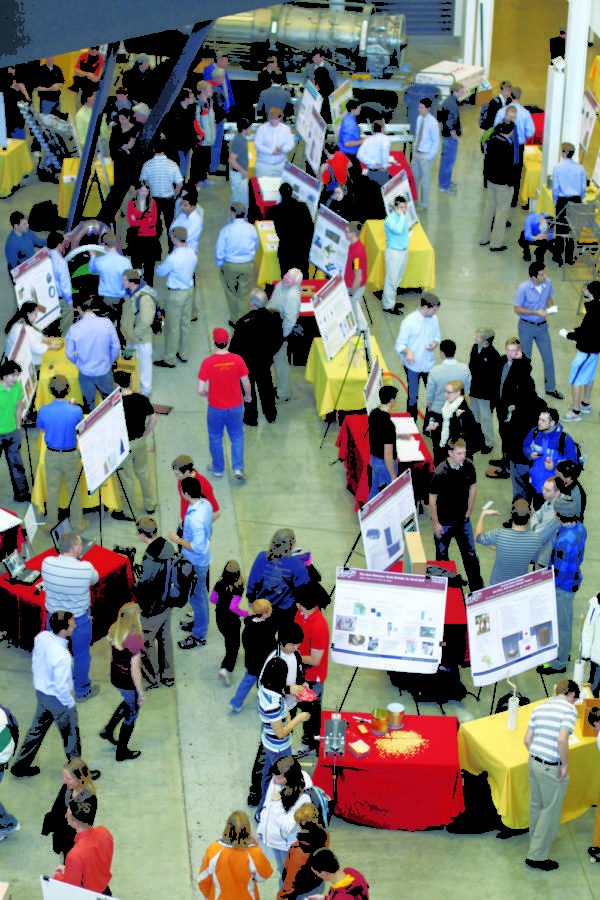Mechanical engineers to show off projects at Design Expo
Photo: Brianna Buenz/Iowa State Daily
Students and community members visit various displays during the mechanical engineering design expo on Tuesday December 6, 2011. The expo was held in Howe Hall and showcased multiple prototypes designed by students.
April 29, 2013
An anti-mosquito water agitator, a paddle wheel generator and a high leverage wheelchair will be among the more than 70 projects on display at the spring Mechanical Engineering Design Expo.
The expo will take place from noon to 4 p.m. at the Howe Hall atrium on April 30, 2013.
The event will feature projects from four mechanical engineering courses; Mechanical Engineering 270: Introduction to Mechanical Engineering Design, Mechanical Engineering 415: Mechanical Systems Design, Mechanical Engineering 466: Multidisciplinary Engineering Design and Mechanical Engineering 490: Independent Study.
Mechanical Engineering 415, the most populated senior design course, pairs students with industry sponsors in efforts to supply students with real-world engineering applications.
“ME 415 is entirely sponsored projects from Iowa companies, from connections with the Center for Industrial Research and Service, or internal projects that are associated with certain clubs with outside funding,” said William Ross Morrow, assistant professor of mechanical engineering and co-creator of the expo.
Mechanical Engineering 466, another senior-oriented course, focuses on multidisciplinary design, an approach that mirrors situations many engineers face in the industry.
“Engineers, mechanical engineers in particular, go out into industry and often have to work with a variety of different engineers and people in all sorts of disciplines. Companies are interested in hiring people that have that experience already,” Morrow said.
Mechanical Engineering 466 projects will mainly feature aspects of aerospace, electrical and mechanical engineering.
Mechanical Engineering 490, the last of the senior-oriented courses, is an independent study option some students opt for that allows for flexibility in terms of what the project may accomplish.
Nearly half of the projects found at the expo will come from Mechanical Engineering 270, a sophomore-oriented course.
The designated theme Mechanical Engineering 270 students were given was to create a design for developing regions around the globe.
“We call the project design a microeconomy kit. That’s something that should not only be a product or service or system that helps improve the quality of life for a region, but also creates economic activity,” Morrow said.
One project from a Mechanical Engineering 270 group is an anti-mosquito water agitator, which will aim to help regions of Africa suffering from widespread cases of malaria.
The agitator “aerates water and agitates it through a piston system. Its function is to prevent the spread of malaria because mosquitos lay eggs on still water. By agitating it, we can prevent its spread and save people time and resources,” said Robert Garcia, sophomore in mechanical engineering.
Another project hopes to provide an alternative power source for Lachung, a town in the impoverished state of Sikkim, India.
“Our group has created a paddle-wheel generator. We researched the area to see how much power they get, which isn’t a lot. So we made this device that you put in a river, and it would generate power for a small village or household,” said Ryan Kinsella, senior in mechanical engineering.
A third group has made adjustments to the Leveraged Freedom Chair, a wheelchair created by Massachusetts Institute of Technology postgraduate students designed to handle different terrains.
“It doesn’t have rims on the outside of the wheels. It has two levers attached to a machine in front of the system on either side. The user would be able to generate a higher amount of torque with each push by simply gripping higher on the lever,” said Alex Kraft, junior in mechanical engineering.
The way the group has adjusted the design is by means of a lighter, less expensive composition.
“With our design, what we wanted to do was try to reduce the weight of the chair. The first thing we came up with was we wanted to make as much of it the same as possible out of either PVC pipe or just bike shafting parts,” Kraft said.







